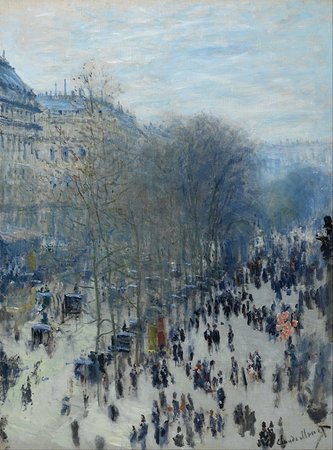
Claude Monet, Boulevard des Capucines, 1873-74, oil on canvas, 80.3 x 60.3 cm (Nelson Atkins Museum of Art, Kansas City, Missouri)
The First Impressionist Exhibition, 1874
Although the idea originated with Claude Monet, Degas is largely responsible for organizing the very first Impressionist exhibition. After much debate, the artists—including Degas, Monet, Renoir, Morisot, Pissarro, Sisley, Boudin, and even the young Cézanne—along with many other lesser-known figures, chose to call themselves the Société Anonyme des Artistes. This group included painters, sculptors, printmakers, and others.
The exhibition opened in Paris on April 15, 1874. It was held at 35 Boulevard des Capucines, on the top floor and former studio of the photographer, Gaspard-Félix Tournachon, better known as Nadar. He was a friend of several of the artists and well-known for his portraits of the Parisian literati.

35 Boulevard des Capucines, workshop of Nadar and location of the first Impressionist exhibition in 1874
Serious criticism or tongue-in-cheek?
Although the first Impressionist exhibition was well attended, the critics were merciless. Trained to expect the polished illusions of the Salon painters, they were shocked by the raw, unblended, ill-defined paint used by Degas, Renoir, Monet and company. The satirical magazine, Le Charivari published an account of a visit with Joseph Vincent, an accomplished and conservative painter:
Upon entering the first room, Joseph Vincent received an initial shock in front of the Dancer by M. Renoir.
‘What a pity,’ he said to me, ‘that the painter, who has a certain understanding of color, doesn’t draw better; his dancer’s legs are as cottony as the gauze of her skirts.’…
Unfortunately, I was imprudent enough to leave him [Joseph Vincent] in front of the “Boulevard des Capucines,” by [Monet].
‘Ah-ha! he sneered…. Is that brilliant enough, now!’ ‘There’s impression, or I don’t know what it means.’ ‘Only be so good as to tell me what those innumerable black tongue-lickings in the lower part of the picture represent?’
‘Why, those are people walking along,’ I replied.
‘Then do I look like that when I’m walking along the Boulevard Capucines?’ ‘Blood and Thunder!’ ‘So you’re making fun of me!’ ‘…What does that painting depict?’ ‘Look at the Catalogue.’ ‘Impression Sunrise.’ ‘Impression–I was certain of it. I was just telling myself that, since I was impressed, there had to be some impression in it…and what freedom, what ease of workmanship! Wallpaper in its embryonic state is more finished than that seascape!'”¹

Claude Monet, Impression, Sunrise, 1872, oil on canvas, 48 x 63 cm (Musée Marmottan Monet, Paris)
And on it goes, ever more sarcastically. The article was titled, “Exhibition of the Impressionists,” and the term stuck. From then on, these artists were called Impressionists.
1. Linda Nochlin, Impressionism and Post-Impressionism, 1874-1904: Sources and Documents (Englewood Cliffs: Prentice-Hall, 1966), pp. 10-13.
Additional resources:
Impressionism: Art and Modernity from The Metropolitan Museum of Art’s Timeline of Art History
Smarthistory images for teaching and learning:
[flickr_tags user_id=”82032880@N00″ tags=”ImpIntro,”]

